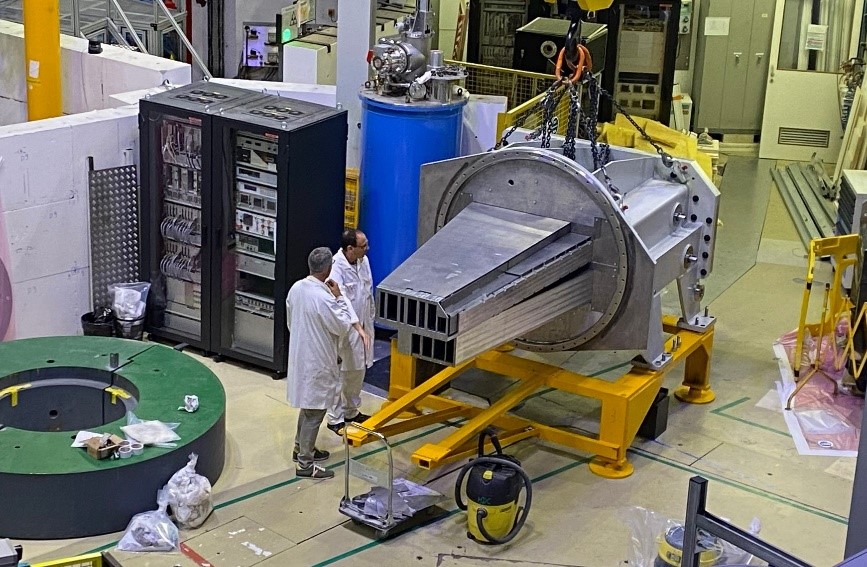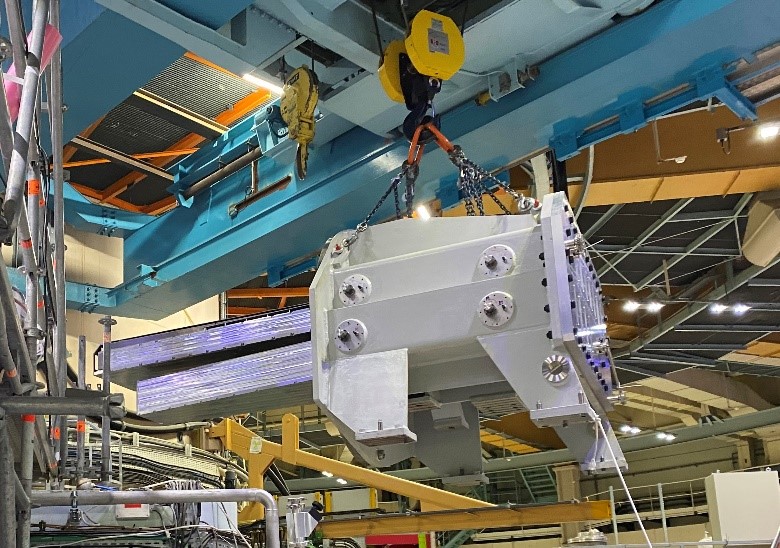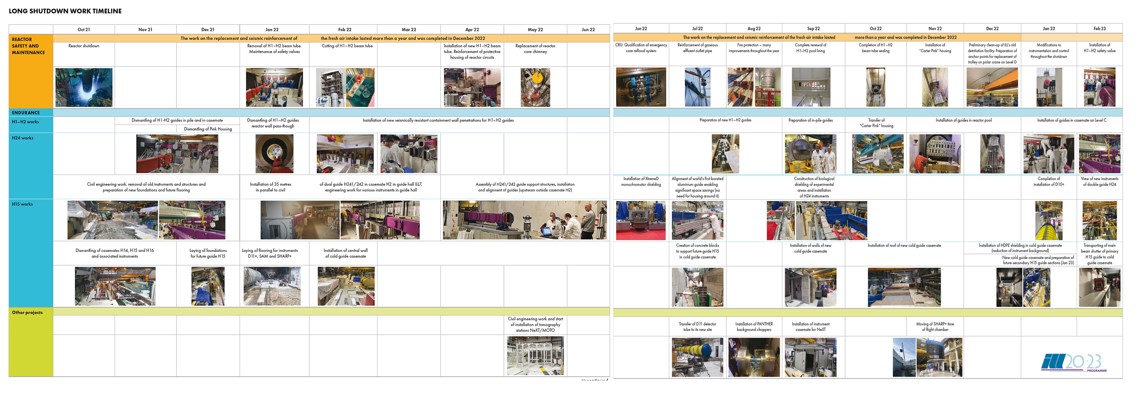ILL20-23
The ILL20-23 programme
ILL20-23 is a major programme of maintenance and upgrade work covering Reactor Division, Endurance and other projects and spanning several long reactor shutdowns. The aim of ILL20-23 is to ensure that the projects are properly planned and coordinated in order to guarantee a maximum number of cycles for our scientific users, namely 3 cycles a year, except during exceptional extended shutdown periods needed for regulatory compliance work, while at the same time successfully completing all the work scheduled for each of the long shutdowns.
It is ILL' s declared goal to ensure the delivery of high-quality beam time in the coming decade, while maintaining high levels of safety and security, and in particular respecting the dedicated action plan associated with the ten-year safety review (Groupe Permanent) and the timetable for the implementation of physical protection systems.
The period has seen a number and volume of projects (Hl-H2, central reactor chimney, ten-year safety review action plan, new guides H15 and H24 associated with various Endurance projects, physical protection, detritiation, cold source maintenance, fuel conversion, etc.). These various maintenance and upgrade projects are decisive for ILL' s future, as they will lay the foundations for ensuring ever-safer operation of the neutron source and world-class scientific performance from its instrument suite. For their implementation, these projects require extended shutdown times, which ILL undertakes to limit to the strict minimum in order to safeguard the quality of our user programme. This means strengthening the coordination of activities, which is the raison d'etre of the ILL20-23 programme.
The 10-year Re-Qualification of the Reactor Vessel project fell within the scope of ILL20-23 and was successfully completed on time in January 2021. The forthcoming shutdown will last over a year, beginning at the end of 2021. Its objectives include the replacement of the H1-H2 beam tube and the completion of a number of major Endurance guide and instrument projects.
As ILL20-23 progresses, the ILL will gradually complete a series of major modernisation milestones focussed on maximising the availability of neutrons, instruments and services for the European user community.
December 2022: spotlight on the ILL 20-23 work in the guide halls
Autumn 2022 saw a huge amount of progress on the neutron guides and instruments, keeping us on track with the planned schedule.
The most critical project for the restart of the instruments is the installation in ILL5C of the H1-H2 guides, which deliver neutrons to ILL7. How to install 250 m of neutron guides with an accuracy of a few hundredths of a millimetre in just two months. This is the challenge the Test Hall team must meet so that the eleven H1-H2 safety valves can be reinstalled, a prerequisite for fuel loading, final testing and reactor restart before the end of February.
The first phase involved transporting and then inserting the first sections of the 11 guides into the new H1-H2 beam tube and making the whole assembly leaktight. This operation, which combined the very delicate handling and precise positioning (to a tenth of a millimetre) of the 7400 kg assembly, was decisive to be able to get guide hall ILL7 back into service. And, of course, there could be no room for error as far as the safety of the reactor was concerned.
But now it’s all done! The operation was executed on 23 November by SMAE’s Test Hall team, the handling team and the members of the Design Office, in perfect coordination with the reactor block teams of the Reactor Division.
 |
| Beside the in-pile parts of the H1-H2 guides mounted on to the “Carter Pink” housing: 7400 kg of high-precision mechanical engineering. |
 |  |
| The in-pile guide/Carter Pink mechanical assembly being lifted towards the H1-H2 beam tube |
Now that this assembly has been inserted into the beam tube and made leaktight, work has begun on reinstalling the guides in the reactor pool. We have made excellent progress so far, thanks to the great job done by the Design Office on designing the assembly and a huge amount of preparatory work done upstream: we are even slightly ahead of schedule.
The other prerequisite for restarting the user programme in ILL7, namely the construction of the new casemate, was successfully completed on time despite the unexpected breakdown of the overhead crane. This 300m2 structure made of concrete, lead and steel has been specially designed for three future branches of the guide H15, which will supply neutrons to the new instruments D11+, SAM, SHARP, D007 and T3+. The construction of this casemate was vital to ensure the safe distribution of neutrons to users for the restart: it is now a done deal. Once the flooring of the new instruments was completed, the time-of-flight chamber of SHARP+ lifted off and headed for its final position at the end of the ILL7 guide hall. It landed safe and sound, expertly guided by the teams from SAE and SMAE. (cick to enlarge picture --->) |  (jpg - 116 Ki) (jpg - 116 Ki) |
Things may be going full steam ahead in ILL7, but the instruments in ILL22 and on Level C certainly aren’t being neglected either with the replacement of the Fresnel coils on WASP, the installation of the new D16 detector and, on the new tomography instrument NeXT, the setting-up of the collimation system and the neutron camera translation system and the preparation of the second tomography station “Moto”. On Level C, the choppers on Panther have been installed and tested and IN20 has been reassembled with its new spectrometer following the repair of the H13 shutter.
After 13 months of work in the guide halls, the results are plain to see. All of the work scheduled is on track to be completed on time, thanks to the tireless efforts of all of the ILL's technicians and engineers.
We’re now into the home straight and continue to remain fully focussed in order to guarantee the restart of the reactor and the user programme in February, and to demonstrate once again that the ILL’s greatest strength is its staff!
End of May 2022 | Successful review by the Programme Advisory Committee
The ILL2023 Programme Advisory Board (1) met for two half days, during which several presentations were made on the progress of the H1H2, the Endurance programme and plans for the future. The meeting also included tours of the experimental halls and the reactor building.
The committee was impressed by the progress made and the excellent continuity despite the impacts of COVID. It was able to see that the programme is well underway and on track, with many notable successes: a new beam tube for the large ILL7 experimental hall, a new reactor primary cooling stack, preparation of the In Pile guides, progress on the new reactor building fresh air inlet, and completion of the major civil works for the future H24 and H15 instruments, as well as the H1H2, H15, H241 and H242 neutron guides.
Completion of the work programme remains a challenge, but it appears to be on track and reliable for restart as planned.
(1) At the start of the ILL2023 programme, the ILL Associates tasked the ILL Director with establishing a Programme Advisory Committee (PAC) to advise him on the management of the programme. The PAC is composed of five external members from leading US and European research infrastructures, chosen for their expertise in managing complex projects. Their combined experience covers the full range of projects included in the ILL20/23 programme, from reactor maintenance operations to the implementation of neutron guides and instrument upgrades (Endurance 2). #ILL2023
"The committee was very impressed with the progress made, the excellent continuity despite the changes in the ILL management team and COVID impacts and also considering that the ILL had to navigate through financial challenges with some partner countries. The committee would like to congratulate the management team, as well as the ILL20-23 team, and all ILL staff for the impressive achievements since Sept 2021".
Laurent Chapon, Chairman of the Programme Advisory Committee
Timelapses
The replacement of the H1-H2 beam tube is a good example of the unique conditions encountered on nuclear work sites due to the associated radiological, safety and regulatory constraints. For instance, standard tools cannot be used on this type of work site. All the tools used were therefore specially developed at the ILL. In addition, for radiation protection reasons, most of the work must be carried out under 6 metres of water.
Replacement of the H1H2 Beam tube - long version - 2022
Replacement of the H1H2 Beam tube - short video
Turning over the H1-H2 beam tube
DrE H1-H2 - divers in the pool
Timelapse Guide hall ILL7 April May 2022
H15 - Floors - December 2021
Update as of May 2022
The long shutdown works are right on plan in technical terms, and with respect to the ILL20-23 budget and timeline. At present, a restart at the beginning of December 2022 remains a challenging but still realistic reference target (soonest restart) since our two month contingency could remain unused (latest restart begin of feb 2023).
The H1-H2 beam tube ‑ which distributes the neutrons to the whole of the ILL 7 experimental hall – is now installed in the reactor block.
The reactor teams are now preparing the remaining projects, and in particular for the safety test which has to be performed to ensure that the fuel element will remain under water in even the worst scenario. Other operations are being carried out in parallel.
As for the instruments, the work is progressing apace. There is also progress on H24. The concrete floors have been laid for future instruments D10+ and XtremD, right on time for the installation of the marble slabs. The new H24 guide in ILL7 has been installed and three-quarters aligned. Things are also going well on the other side of the hall, with H15: the foundations have been laid for future instruments SAM and D11+ and work is proceeding as planned for the future cold guide casemate. Another big guide project is being completed on time these days (replacement of the eleven ill5/ill7 guides mechanical system crossing the reactor wall, to comply with new seismic requirements)
Finally, there's the future neutron imaging station NEXT, which will be taking over from the neutron tomography instrument D50: a tailor-made floor slab is ready and the NEXT mechanical structure is installed allowing work to start on the construction of the instrument in May.
Feb 22: Glimpse of the work sites in ILL7 experimental hall
Enjoy these two panorama views of ILL7:
- Chartreuse side (html - 1.16 Ki) (west)
- Vercors side (html - 1.16 Ki) (east)

 (pdf - 41 Mi)
(pdf - 41 Mi)